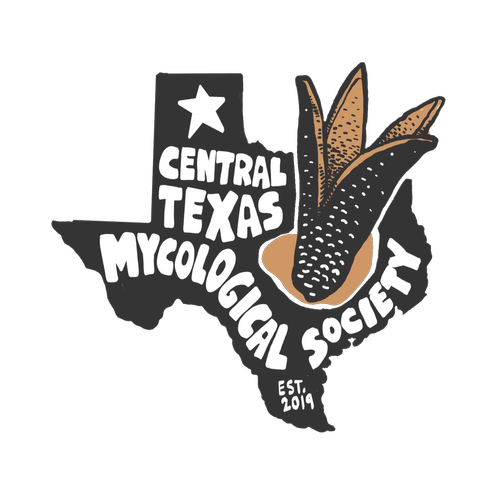There are a lot of different types of edible mushrooms poppin' off in May and after all the recent rain, the following are mushrooms to look out for in Central Texas.
CHANTERELLE: Keep a look out for the popular edible mushroom Cantharellus. In Central Texas, they are symbiotic with older Texas Live Oaks trees that have a lot of leaf matter, making the ground spongy. Trees near creeks and where water is flowing is very important. Chanterelles need a lot of rain to fruit and they like the torrential Texas-style flash floods. They are orange, yellow or even white, meaty and funnel-shaped and can be found in clusters but most of the time they are found popping up as individual mushrooms as shown in the picture. On the lower surface, underneath the smooth cap, most species have rounded, forked folds that run almost all the way down the stipe, which tapers down seamlessly from the cap. Many species emit a fruity aroma, reminiscent of apricots, and often have a mildly peppery taste. The Jack-o-lantern, Omphalotus illudens is considered the false chanterelle in Texas so be sure to know the morphology and difference. They do sometimes grow around the same time of year but their habitat and morphology is different.
OYSTER: Continue to keep an eye out for Oyster Mushrooms, Pleurotus ostreatus grows on dead black willows and oaks along creeks and rivers.
WOOD EAR: In the Auricularia family and are an edible jelly fungus that pops up on downed hardwood limbs just a few days after a good rain. The fruiting body is distinguished by its noticeably ear-like shape and brown colouration which is because wood ears have more melanin which also helps protect them from harsh environments such as those found in areas of radiation exposure. All good things for taking a melfie.
A 2012 paper with the forbidding title Compton Scattering by Internal Shields Based on Melanin-Containing Mushrooms Provides Protection of Gastrointestinal Tract from Ionizing Radiation describes this work. The authors fed mice a wood ear mushrooms an hour before giving them a powerful 9 Gy dose with the beta emitter Cesium137. For perspective, anything over ~0.1 Gy is considered a dangerously high dose for humans. All the control mice died in 13 days while ~90% of the mushroom-fed ones survived. Mice fed a white mushroom (porcini) died almost as fast as the controls, but those fed white mushrooms supplemented with melanin also survived.
More recently, research from Northwestern University isolated the naturally occurring melanin from the fungal cells, etching biomaterials away and leaving a melanin-containing shell - "fungal ghosts" for their hollow, ghost-like quality.
Wood ears are grown commercially (not in Texas yet???) and are a popular ingredient in many Chinese dishes. I had them recently in a congee with 5 different foraged mushrooms.
They are also used in Chinese medicine. A soup containing the species is used medicinally for dealing with colds and fevers by reducing the heat of the body It is also used in Ghana as a blood tonic. Modern research into possible medical applications has variously concluded that wood ear has anti-tumor, hypoglycemic, anticoagulant and cholesterol-lowering properties.
RINGLESS HONEY MUSHROOMS: Desarmillaria tabescens pop up in the spring and fall in large clusters at the bases of dead or dying trees (when the clusters appear to be terrestrial they are actually growing from underground wood). This parasitic fungus is part of a genus that is the largest living organism ever found on this planet.
JACKSON'S SLENDER CAESAR Amanita jacksonii, or Jackson's Slender Caesar, is an edible mushroom found in oak and pine forests. They are more common in East Texas but they can be found in Central Texas. It is easy to spot with its brilliant red cap that fades from the outer edge to the center with age. The stem of the mushroom is yellow with orange fibrils. The cap of the mushroom can grow to 4 inches; oval at first, then becoming convex with a central bump. the gills are crowded, orange-yellow, and free from the stem. The flavor is of hazelnuts and chestnuts.
As always, if you are trying a new mushroom, confirm the ID with an expert, then try a small amount to make sure you don't have an allergic reaction. Texas Mushroom Identification Facebook group is great for quick responses and ID help. Also, don't forget to add your finds on the Mushrooms of Texas project on iNaturalist.
Follow my foraging adventures @forage.atx.






